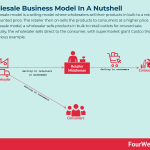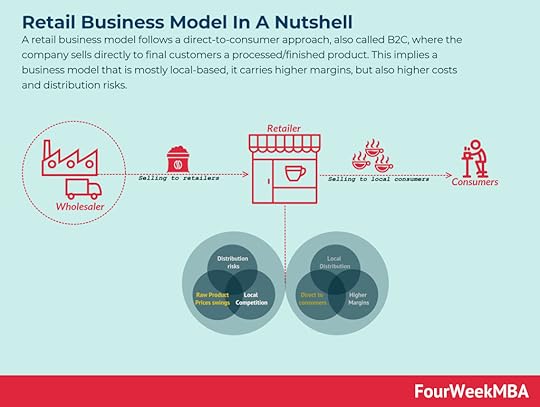What Is The Wholesale Business Model? Wholesale Business Model In A Nutshell


The wholesale model is a selling model where wholesalers sell their products in bulk to a retailer at a discounted price. The retailer then on-sells the products to consumers at a higher price. In the wholesale model, a wholesaler sells products in bulk to retail outlets for onward sale. Occasionally, the wholesaler sells direct to the consumer, with supermarket giant Costco the most obvious example.
Understanding the wholesale modelWholesalers receive attractive prices from the manufacturer because they deal in large minimum order quantities (MOQs), with larger order quantities reducing handling time and cost and increasing profit. In some cases, the wholesaler and the manufacturer are the same company.
In a traditional wholesale model supply chain, goods may flow from raw material suppliers to manufacturers, distributors, wholesalers, retailers, and finally to consumers. Since most wholesalers do not sell directly to the consumer in small quantities, they sell bulk goods to retail businesses for a profit.
The wholesale model is a business-to-business (B2B) process since wholesalers buy from a manufacturing business and sell to a retail business. This differentiates the model from the retail model, a business-to-consumer (B2C) process where retailers buy from wholesale businesses and sell to individual consumers.
Functions of wholesalers in the wholesale modelMany companies utilize wholesalers and the wholesale model because of the impracticalities of selling direct to consumers. This is particularly true of large retailers, who may operate thousands of stores in hundreds of different regions.
To that end, some wholesalers act as middlemen for retailers and are vital cogs in the supply chain. Here are some of their functions:
Sales and promotions – wholesalers are typically responsible for meeting sales targets for their particular region through promotional campaigns. Inventory management – maintaining sufficient inventory is a critical function of any supply chain. Experienced wholesalers understand that different products sell at different rates. They then use this information to avoid overstocking and understocking issues across the supply chain.Breaking the bulk – when a wholesale company receives a bulk order, it must necessarily break the order down into smaller cartons or consignments ready for delivery to the retailer. Warehousing – to supply a whole region, wholesalers require a large warehouse space to store inventory. Warehouses must be large enough to accommodate the extra demand for stock during holidays such as Christmas. The warehouse itself must also be economical to operate and not eat into margins.Risk management – in most cases, wholesalers are also responsible for inventory losses incurred because of theft, fire, or accidental damage. This makes risk management a priority.Market information – wholesalers have a good understanding of the size and potential of a market and share this information with intermediaries up and down the supply chain. Some may also have information on how strong a competitor’s business is in a specific region, which is valuable information to retailers and other wholesalers alike.The benefits of buying and selling under the wholesale modelLet’s take a look at some of the benefits of buying and selling under the wholesale model.
BuyingCost and time reduction – as mentioned earlier, buying in bulk helps a business save money on most product ranges. For the retailer, the purchasing process is also more efficient. Wholesalers deal with multiple suppliers for every product, but the retailer only needs to do business with one wholesaler.Better deals – dealing with multiple suppliers, the wholesaler can quickly identify reputable companies who deliver high-quality products on time and at a reasonable price. This work also saves the retailer from finding reputable suppliers themselves.SellingHigher margins – selling under the wholesale model may require dealing with multiple suppliers and comparison shopping to get the best deal. However, this allows a business to buy low and sell high. Selling direct to consumers will earn the highest margins, while selling to retailers usually attracts a slightly lower (though still attractive) margin.Responsiveness – sellers also have a better understanding of high-demand products since they work with both retailers and customers. With supplier relationships already in place, wholesale sellers can also launch new products more quickly than competitors. What’s more, some wholesalers have a deep working knowledge of the timing and organization of the entire supply chain, which gives them a competitive edge.Key takeaways:The wholesale model is a selling model where products sell their products in bulk to a retailer at a discounted price. The retailer then on-sells the products to consumers at a higher price.The wholesale model helps larger retailers with the impracticalities of selling direct to consumers. Wholesalers perform several critical functions relating to sales and promotions, inventory management, warehousing, risk management, and the divulging of market information.For buyers, the wholesale model reduces the time and cost associated with securing multiple suppliers. For sellers, the ability to buy in bulk increases margins when dealing directly with the consumer. Wholesale sellers also have a deeper understanding of the market and supply chain itself, which increases competitiveness.Read Also: Costco Business Model
 Costco runs a high-quality, low-priced business model powered by its memberships that draw customers’ loyalty and repeat purchases. Top institutional investors comprise The Vanguard Group, with 8.55%, and BlackRock with 5.39%. Top individual shareholders comprise Craig Jelinek, Charles T. Munger (Warren Buffet partner and co-owner of Berkshire Hathaway), James Murphy, and more.
Costco runs a high-quality, low-priced business model powered by its memberships that draw customers’ loyalty and repeat purchases. Top institutional investors comprise The Vanguard Group, with 8.55%, and BlackRock with 5.39%. Top individual shareholders comprise Craig Jelinek, Charles T. Munger (Warren Buffet partner and co-owner of Berkshire Hathaway), James Murphy, and more. Read Also: Marketplace Business Models
 A marketplace is a platform where buyers and sellers interact and transact. The platform acts as a marketplace that will generate revenues in fees from one or all the parties involved in the transaction. Usually, marketplaces can be classified in several ways, like those selling services vs. products or those connecting buyers and sellers at B2B, B2C, or C2C level. And those marketplaces connecting two core players, or more.
A marketplace is a platform where buyers and sellers interact and transact. The platform acts as a marketplace that will generate revenues in fees from one or all the parties involved in the transaction. Usually, marketplaces can be classified in several ways, like those selling services vs. products or those connecting buyers and sellers at B2B, B2C, or C2C level. And those marketplaces connecting two core players, or more.Read Also: Food-Delivery Business Models
 In the food delivery business model companies leverage technology to build platforms that enable users to have the food delivered at home. This business model usually is set up as a platform and multi-sided marketplace, where the food delivery company makes money by charging commissions to the restaurant and to the customer. Wholesale vs. Retail
In the food delivery business model companies leverage technology to build platforms that enable users to have the food delivered at home. This business model usually is set up as a platform and multi-sided marketplace, where the food delivery company makes money by charging commissions to the restaurant and to the customer. Wholesale vs. Retail  A retail business model follows a direct-to-consumer approach, also called B2C, where the company sells directly to final customers a processed/finished product. This implies a business model that is mostly local-based, it carries higher margins, but also higher costs and distribution risks.
A retail business model follows a direct-to-consumer approach, also called B2C, where the company sells directly to final customers a processed/finished product. This implies a business model that is mostly local-based, it carries higher margins, but also higher costs and distribution risks. Where the retailer takes the risks of dealing with final customers, the wholesaler primarily deals with intermediaries/retailers that will take care of dealing with the final customers.
This, of course, has an advantage in terms of sales and marketing expenses. As the wholesaler will have fewer business risks, compared to the retailer. However, the wholesaler will need to spend a substantial amount of effort in developing its logistics infrastructure.
On the other hand, as the wholesales deal with the intermediaries, and at higher volume, and in some cases, for raw goods, it will also make fewer margins per product, as its business model will be based on volume.
The retailer, on the other hand, will enjoy wider margins per product, and it will have to carry a higher risk in terms of meeting a wider customer base. Therefore, a good chunk of its efforts will be spent on sales and marketing activities.
Wholesale vs. Direct-to-consumer Direct-to-consumer (D2C) is a business model where companies sell their products directly to the consumer without the assistance of a third-party wholesaler or retailer. In this way, the company can cut through intermediaries and increase its margins. However, to be successful the direct-to-consumers company needs to build its own distribution, which in the short term can be more expensive. Yet in the long-term creates a competitive advantage.
Direct-to-consumer (D2C) is a business model where companies sell their products directly to the consumer without the assistance of a third-party wholesaler or retailer. In this way, the company can cut through intermediaries and increase its margins. However, to be successful the direct-to-consumers company needs to build its own distribution, which in the short term can be more expensive. Yet in the long-term creates a competitive advantage. Similar to the distinction between wholesalers and retailers, the direct-to-consumer business will have to take the risks of dealing with the final customers. Usually, this requires a bigger effort, in securing this customer base, in supporting it before and after the sale.
Thus, the direct-to-consumers expenses related to customer acquisition, retention, and referral will be substantial. Thus, here you’ll see this projected on the balance sheets.
Where the wholesaler will have most of its expenses as “cost of sales” (meaning the costs needed to sustain its infrastructure), the direct-to-consumer might have most of its expenses tied to sales and marketing activities.
Wholesale vs. Private Labeling Private labeling involves one company selling the products of another company using its own branding and packaging. In most instances, a retailer purchases products from a manufacturer that are then sold to consumers with the manufacturer’s brand and packaging visible. In private labeling instead, the retailer might have a third-party manufacturer produce goods and sell them under the retailer’s brand. Therefore the manufacturer acts as a private label, not showing its brand toward consumers.
Private labeling involves one company selling the products of another company using its own branding and packaging. In most instances, a retailer purchases products from a manufacturer that are then sold to consumers with the manufacturer’s brand and packaging visible. In private labeling instead, the retailer might have a third-party manufacturer produce goods and sell them under the retailer’s brand. Therefore the manufacturer acts as a private label, not showing its brand toward consumers.In the case of the private label, the retailer sells to final consumers the products that the manufacturer has passed along with its own labels. The main difference with the wholesaler is that the private labeler does show its brands to final consumers, and therefore there might be some activities of post-sales support who go with the manufacturer.
On the contrary, in most cases, the wholesaler only sends over goods that might be unlabeled or labeled with other brands’ names (related to third-party manufacturers) and therefore, it doesn’t have to carry the expenses related to post-sales support.
Read More:
Business ModelsBusiness StrategyMarketing StrategyBusiness Model InnovationPlatform Business ModelsNetwork Effects In A NutshellDigital Business ModelsThe post What Is The Wholesale Business Model? Wholesale Business Model In A Nutshell appeared first on FourWeekMBA.



